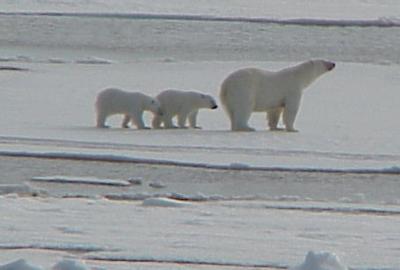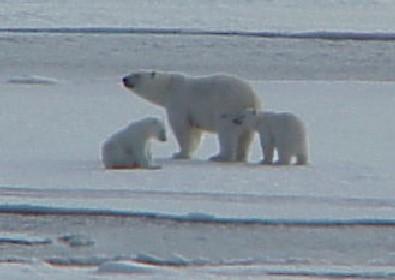20 June, 2000
20 June 2000
Finding Bears and Finding Bottom
Finding things at sea can often be a challenge. Today Iím going to focus
on finding two different things - polar bears and characteristics of the
ocean bottom. Letís focus of the fuzzy one first.
Polar bears (Ursus maritimus) are marine mammals that spend most, if not
all, their time on and around sea ice. They have a thick layer of fat that
helps to insulate them from the cold air and water of their home
environment. Their translucent hair almost makes them look light yellow
against the white of the ice. Seeing a polar bear in the wild has long been
a dream of mine (right up there with narwhals). Yesterday that dream came
true. In the afternoon we caught a glimpse of a bear out on the ice edge as
we were steaming north at 16 knots. It quickly disappeared into the
distance behind us, but I had seen my first actual bear after seeing
hundreds of tracks last week. The fun wasnít over though - last night we
had an even better look.
As we headed back through the ice looking for places to do coring and
dredging, we spotted two bears about 500 meters away, right in front of the
ship. Then we saw another bear trotting in their direction. It turns out
the first ones we saw were the cubs of the next one we saw. The mother had
been hunting and had kept the cubs out of the way. Evidence of her hunting
ability was evident in the carcass of a seal near where she was first
spotted. The ship slowed and came to a stop and everyone got a nice long
look at the bear family. Cameras fired away as the bearsí images were
recorded by a host of crew and scientists. As the ship slowly pulled away,
the mother leaned back and let her cubs feed on her milk.
Like all mammals, polar bear young are nourished by their motherís milk
until they are old enough to eat ďregularĒ food. Even the whales and seals
we see here in the arctic feed the young milk for a time. Most of these
marine mammals have very high levels of fat in their milk so the young can
grow rapidly and maintain the insulation they so desperately need to keep
warm in their cold, cold home.
One thing to remember about polar bears is that they are found in the arctic
only. Polar bears are NOT FOUND IN ANTARCTICA. You will never see a polar
bear with penguins except in cartoons. If polar bears did live in
Antarctica, they would probably gobble up all the penguins when they came to
land to breed!
Enough about one of my pet peeves, now, back to "How to find a polar bear".
First, spend lots of time looking out over the ice for things that kind of
look like blocks of ice, but are a little bit yellow, and move (not as easy
to distinguish as you might think!). Second, get lucky!! The first
improves your chances of the second.
Finding bears on USCGC Healy is fairly low tech. We arenít looking for
bears using radio collars or infrared sensors, just binoculars and lots of
pairs of human eyes. Trying to find out about the sea floor surface on
USCGC Healy is a different story, where a collection of high tech tools
helps shipís personnel and researchers identify the characteristics of the
ocean bottom. Two of the most important tools we are using to determine
where to dredge and core are the SEABEAM system and the Knudsen Deepwater
Echo Sounder. Both these systems use sound pulses to gather information
about what lies below the ship. The data they generate however is very
different. SEABEAM maps a wide band of the ocean floor as the ship passes
over, and as this is done continuously, you end up with a map of the
contours of the ocean floor you have just traveled over. This will give you
an idea of what the sea floor looks like from a birdís eye view, very much
like a topographic map for land (see pictures below for a better idea). The
ďKnudsenĒ as it is referred to shows the bottom, not in a wide view, but in
a linear profile. You might wonder what good a straight line is when
SEABEAM gives a nice wide map. What the Knudsen gives you is not just the
surface of the sea floor, but the subsurface as well. What this means, is
that researchers can get an idea of not only the top layer of the ocean
floor, but layers below the surface as well. Why is that important? If a
scientist wants to dredge for solid rock, they want to know if the top layer
is rock or sediments, like mud. If they wish to do a core from the ship,
they want to make sure they have enough sediment depth for the core they
wish to use for collecting data. Otherwise, they will crunch the core when
it plows into solid rock.
Last night while we were cruising though the ice at 71 N latitude, Dr.
Larry Lawver, of the University of Texas at Austin, was monitoring the
SEABEAM and Knudsen looking for a sea bottom that had a steep slope (SEABEAM
info) and was also solid rock (Knudsen info). As we moved into the ice, he
found a steep slope, but it was covered with sediments and would not do for
the dredging. Plans were changed because we then found plenty of relatively
flat spaces with deep layers of sediment that should be suitable for the
coring testing. This morning has been used to get set up for coring off the
starboard side while we are here in the ice. This is one of the main tests
they wish to accomplish on this leg of the cruise and dredging will wait
until we find a suitable place. I will follow up with coring information in
my next journal. So, tomorrow youíll meet some of the people and high tech
processes involved in finding the story held in the sediments at the bottom
of the sea, and while we are in the ice, Iíll keep using the low tech
methods to try and find some more bears.
Note: A big thank you to LT MacDonald for the use of his polar bear
pictures from his digital camera last night. I was using my 35mm camera
with a telephoto lens, and will have to wait until July to see how mine came
out.

A top down contour view of Baby Knoll. Warmer colors indicate shallower water.

Monitors provide a wide variety of information to researchers in the electronics/computer lab.

This screen shows the path of the ship and the chart produced as it moved form lead to lead in the ice.

The "Knudsen". Dark line in middle of screen is ocean bottom, lines below indicate sediment layers.

A 3-dimensional chart produced by the SEABEAM program showing orphan knoll and baby knoll.

Bears on the ice, a dream come true.

Mom and the kids wonder about that big red thing in the ice - USCGC Healy.

Mealtime for the kids.

One of teh sea beam monitors - straight lines indicate "beams" being returned to the ship.
Contact the TEA in the field at
.
If you cannot connect through your browser, copy the
TEA's e-mail address in the "To:" line of
your favorite e-mail package.
|
